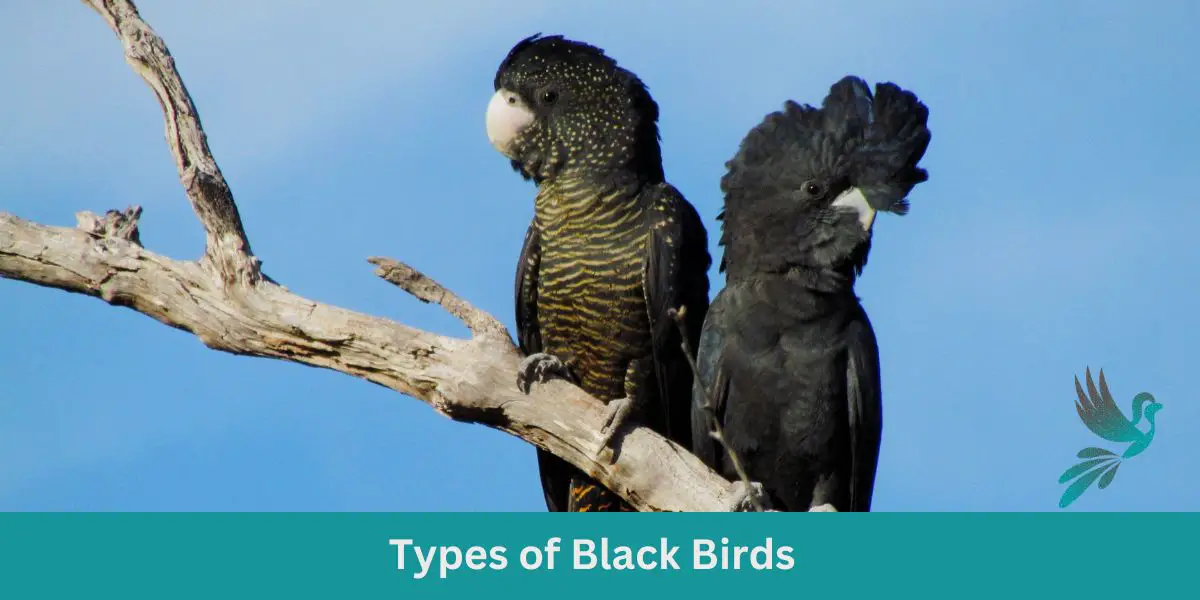When it comes to birdwatching, it’s easy to get swept up in the vibrant colors of birds like parrots and hummingbirds. However, it’s important not to overlook the many types of black birds that inhabit North America. While they may not have flashy feathers, these birds are incredibly intelligent and serve important roles in various ecosystems.
From the American Crow to the Red-winged Blackbird, there are 18 types of black birds that can be found across the continent. While they may not be as eye-catching as some other birds, they are certainly worth paying attention to. In this article, we’ll explore the different types of black birds and their unique qualities.
Key Takeaways
Black birds may not have brightly colored feathers, but they are still important to ecosystems across North America.
There are 18 different types of black birds in North America, each with their own unique qualities.
By learning more about black birds, you can gain a greater appreciation for the diversity of birdlife in North America.
List of Birds That Are Black
Learn about different types of black birds in North America.
Crow
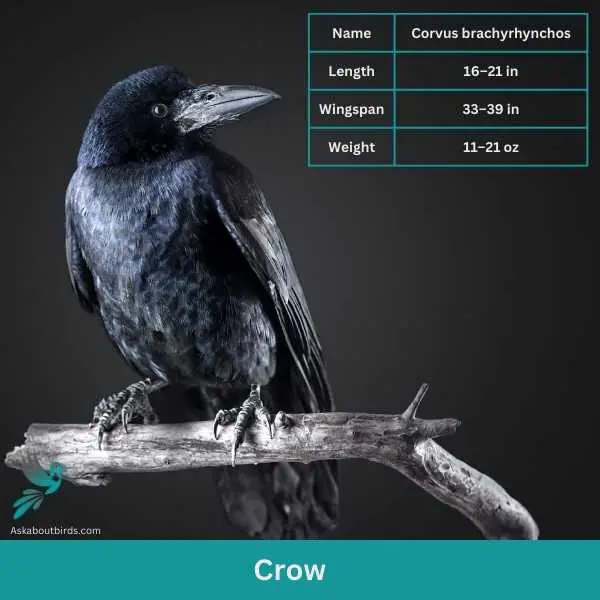
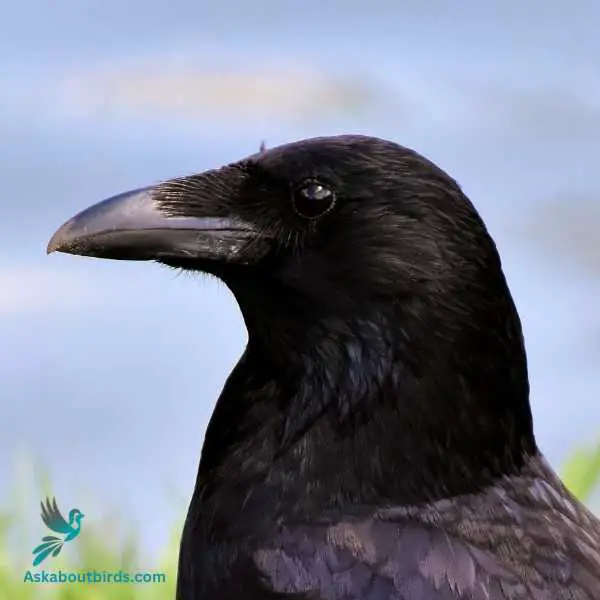
| Feature | Measurement |
|---|---|
| Scientific Name | Corvus brachyrhynchos |
| Length | 16–21 in |
| Wingspan | 33–39 in |
| Weight | 11–21 ounces |
The crow is a common bird found in many parts of the world, known for its distinctive black feathers and cawing call. They are highly intelligent and adaptable, able to thrive in a variety of environments from urban areas to rural forests.
Crows are omnivorous, feeding on a range of foods including insects, small animals, seeds, fruit, and carrion. They are also known to scavenge and steal food from other animals, and have been observed using tools to obtain food.
Crows are known for their intelligence and social behaviors, often forming large flocks and working together to defend their territory or find food. They are also known for their ability to recognize individual humans and remember faces, which has led to them being used in research on animal cognition.
European Starling
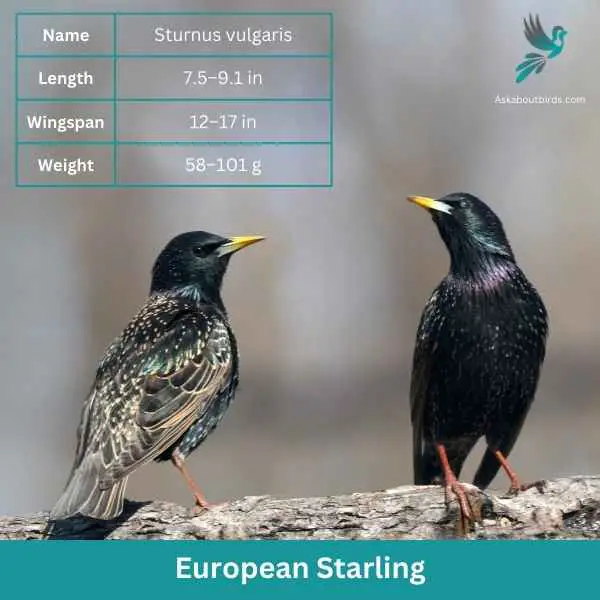

| Feature | Measurement |
|---|---|
| Scientific Name | Sturnus vulgaris |
| Length | 7.5–9.1 in |
| Wingspan | 12–17 in |
| Weight | 58–101 g |
The European Starling is a highly adaptable bird, recognized for its iridescent plumage and uncanny ability to mimic a variety of sounds, from other birds to mechanical noises.
Appearance: European Starlings showcase glossy black feathers with a purple or green sheen, especially prominent during the breeding season. Their winter plumage is speckled with white dots. Both males and females have a similar appearance, but juveniles are gray-brown overall until their first winter.
Diet: These birds are omnivorous, consuming a wide range of foods. Their diet includes insects, seeds, fruits, and occasionally even small vertebrates. European Starlings are known to forage in groups, often seen probing the ground with their strong, pointed bills.
Reproduction: European Starlings are cavity nesters, selecting sites such as holes in trees, buildings, or other structures. After a courtship display that involves singing and wing-flapping, the female lays a clutch of about 4 to 6 eggs
Common Raven


| Feature | Measurement |
|---|---|
| Scientific Name | Corvus corax |
| Length | 21.3-26.4 in |
| Wingspan | 45-51 in |
| Weight | 0.69 to 2 kgs |
The Common Raven is a large, intelligent bird known for its glossy black plumage and its deep, resonating calls. It has a wide distribution and is often associated with myths and legends in various cultures due to its enigmatic nature.
Appearance: Common Ravens are entirely black, from their robust bills to their shaggy throat feathers. Their eyes are dark, and their wingspan is impressive, often mistaken for a hawk or crow. Both males and females share this appearance, though males are typically slightly larger.
Diet: These birds are highly versatile in their diet, feeding on a variety of foods including small mammals, birds, carrion, fruits, grains, and insects. Their adaptability allows them to exploit various food sources depending on availability.
Reproduction: Common Ravens are monogamous and often form long-lasting pair bonds. They typically build large nests made of sticks, often positioned on cliff ledges or high in trees. The female lays a clutch of about 3 to 7 eggs.
Brown-Headed Cowbird

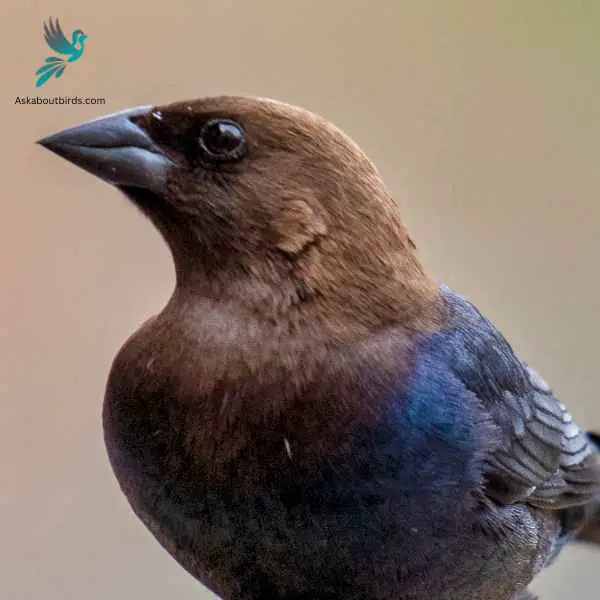
| Feature | Measurement |
|---|---|
| Scientific Name | Molothrus ater |
| Length | 6.3–8.7 in |
| Wingspan | 14 in |
| Weight | 30–60 g |
The Brown-Headed Cowbird is a unique North American bird known for its brood parasitism behavior. Rather than building its own nests, it lays its eggs in the nests of other bird species.
Appearance: Male Brown-Headed Cowbirds are glossy black with a distinct brown head, while females are plain gray-brown without the brown head. Both have a stout shape with a finch-like bill and a short tail.
Diet: Brown-Headed Cowbirds primarily feed on seeds, including grasses and grains. They also consume insects, especially during the breeding season. These birds often forage on the ground, commonly seen in open habitats like fields or pastures.
Reproduction: Unique among North American birds, the Brown-Headed Cowbird is a brood parasite. Instead of building its own nest, the female lays her eggs in the nests of other bird species. The unwitting host then raises the cowbird chick, often at the expense of its own offspring. The female can lay up to 40 eggs in a single breeding season, spread across multiple host nests.
Red-Winged Blackbird
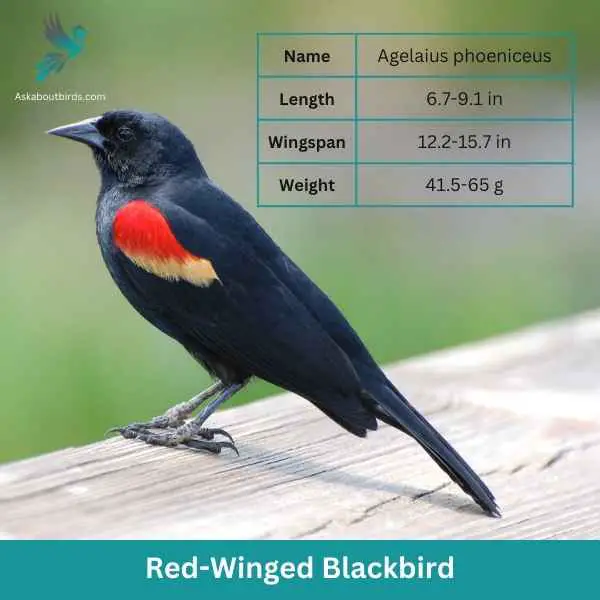
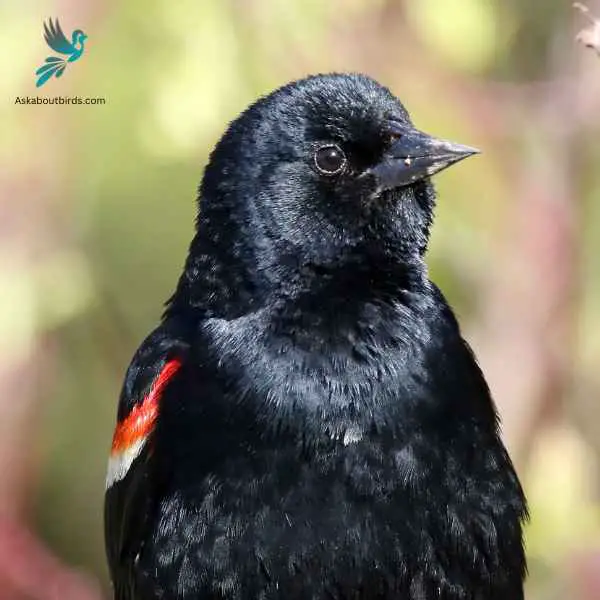
| Feature | Measurement |
|---|---|
| Scientific Name | Agelaius phoeniceus |
| Length | 6.7-9.1 in |
| Wingspan | 12.2-15.7 in |
| Weight | 41.5-65 g |
The Red-Winged Blackbird is a familiar sight across North America, especially in wetlands and open areas. Known for its striking coloration and distinct call, it is often seen perched on cattails or utility lines.
Appearance: Male Red-Winged Blackbirds are glossy black with bright red-and-yellow shoulder patches, while females are streaky brown, resembling a large sparrow. The males’ red patches become more prominent when they’re displaying or agitated.
Diet: Red-Winged Blackbirds primarily feed on seeds and insects. Their diet includes grains, sunflower seeds, and corn, but they also eat beetles, caterpillars, and other small invertebrates, especially in the breeding season.
Reproduction: Red-Winged Blackbirds nest in marshes, along watercourses, and in wet fields. The female constructs a cup-shaped nest using grass and sedge, attaching it to plants above water. She typically lays a clutch of 3 to 4 blue-green eggs, which she incubates for about 11-12 days. Males, being polygynous, often have multiple mates during a single breeding season.
Common Grackle
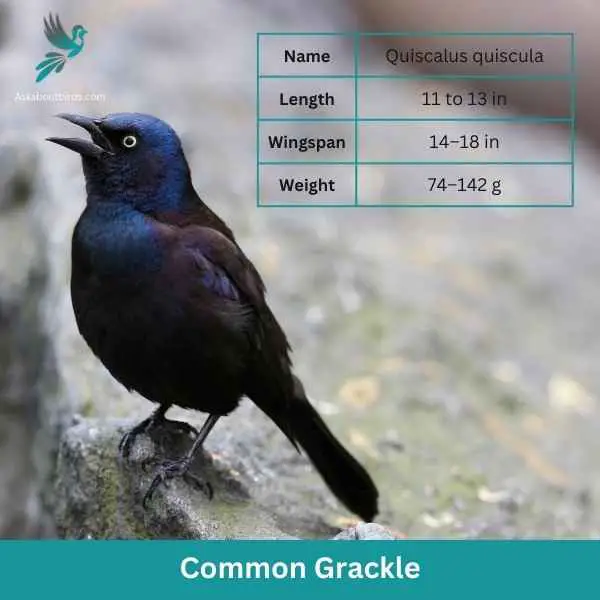

| Feature | Measurement |
|---|---|
| Scientific Name | Quiscalus quiscula |
| Length | 11 to 13 in |
| Wingspan | 14–18 in |
| Weight | 74–142 g |
The Common Grackle is a conspicuous bird found across much of North America, recognized for its glossy-black plumage, long tail, and piercing yellow eyes. Its vocalizations are varied and include a range of harsh, grating calls.
Appearance: The Common Grackle has a sleek black body with a glossy-iridescent sheen that can appear purple, green, or blue in certain lights. Its tail is long and keel-shaped. While both males and females have similar coloration, males are noticeably larger and shinier than females.
Diet: Common Grackles are omnivores. They primarily consume seeds, berries, and insects. However, they are also known to eat small fish, amphibians, and other birds’ eggs, especially when foraging on the ground or in shallow water.
Reproduction: Common Grackles breed in open and semi-open areas. The female typically selects the nest site and constructs a bulky nest made of grasses, twigs, and other plant materials, often in shrubs or trees. She lays a clutch of about 1 to 7 eggs, which are pale blue and spotted with brown.
Black-Billed Magpie

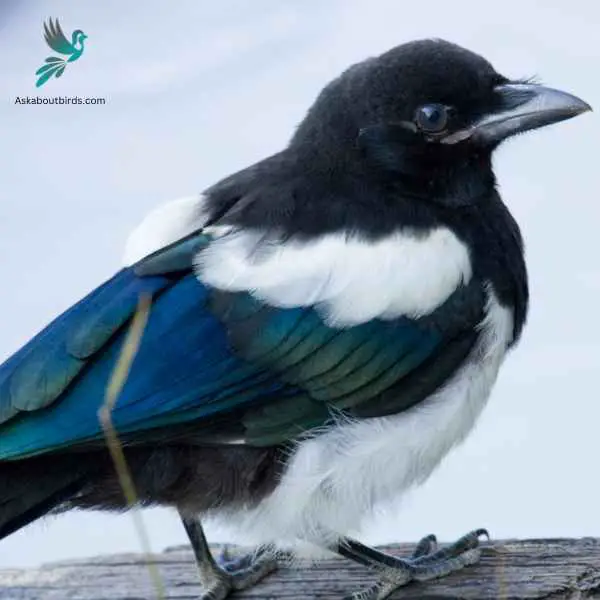
| Feature | Measurement |
|---|---|
| Scientific Name | Pica hudsonia |
| Length | 13.4-15.4 in |
| Wingspan | 27.5-35.4 in |
| Weight | 220-270 g |
The Black-Billed Magpie is a striking bird native to the western half of North America, recognized for its bold black and white plumage and long tail. Its vocalizations are varied, including harsh chatters and melodious notes, and it’s known to be both curious and intelligent.
Appearance: The Black-Billed Magpie has a unique appearance with its glossy black head, chest, and tail contrasting sharply against its white belly and shoulder patches. Its long tail, which is iridescent greenish-blue, is one of its most distinguishing features. The wings also display a hint of iridescent blue-green.
Diet: Black-Billed Magpies are omnivorous and have a diverse diet. They primarily eat insects, especially in summer, but will also consume small mammals, berries, seeds, and carrion. They are often seen scavenging roadkill and are known to store food in the ground for later consumption.
Reproduction: Black-Billed Magpies mate monogamously and usually build large, domed nests in trees or large shrubs. These nests are made from twigs and mud and can be quite elaborate. The female lays a clutch of about 6 to 9 eggs, which are greenish or bluish and speckled with brown.
Black Phoebe
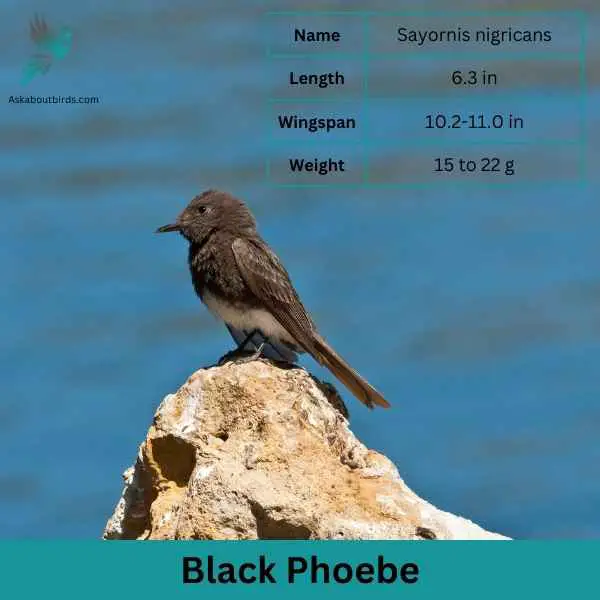

| Feature | Measurement |
|---|---|
| Scientific Name | Sayornis nigricans |
| Length | 6.3 in |
| Wingspan | 10.2-11.0 in |
| Weight | 15 to 22 g |
The Black Phoebe is a distinctive flycatcher commonly found in the western parts of the U.S., recognized for its habit of frequently wagging its tail when perched.
Appearance: The Black Phoebe sports a predominantly black body and head, contrasted by a stark white belly. Its sleek and straightforward coloration easily distinguishes it from other birds.
Diet: Black Phoebes primarily feed on insects, which they catch in mid-air in a characteristic flycatching fashion. They are often seen near water sources, waiting on perches to dart out and grab flying insects.
Reproduction: Black Phoebes build mud nests, usually on vertical surfaces under protective overhangs or eaves. The female typically lays a clutch of 3 to 5 eggs, which are white with small brown markings. The nesting sites are often near or over water, providing added protection from potential predators.
Phainopepla
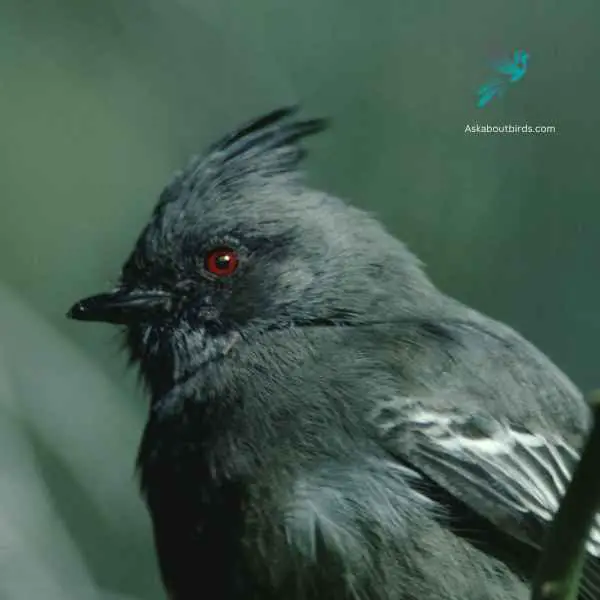
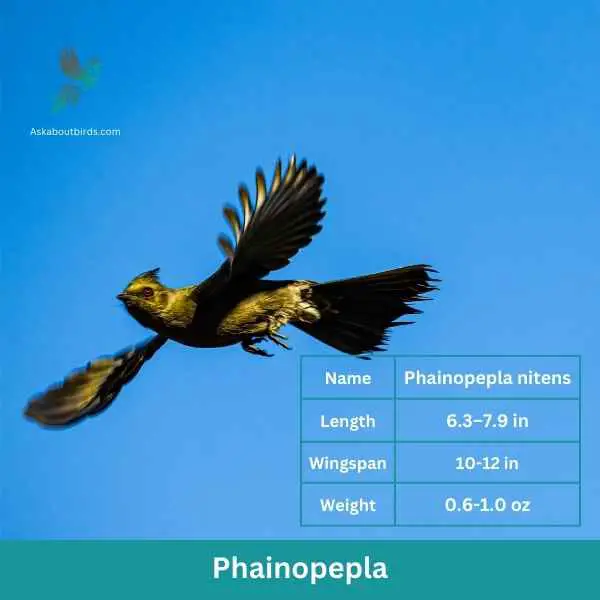
| Feature | Measurement |
|---|---|
| Scientific Name | Phainopepla nitens |
| Length | 6.3 – 7.9 in |
| Wingspan | 10 – 12 in |
| Weight | 0.6 -1 oz |
The Phainopepla is a unique songbird known for its striking appearance and its association with desert habitats, particularly those with mistletoe plants.
Appearance: The male Phainopepla has a glossy black plumage with a distinct crest, while the female is gray with a slight crest. Both genders have deep red eyes, adding to their characteristic look.
Diet: Phainopeplas predominantly feed on mistletoe berries. However, they also consume insects, especially during the breeding season, catching them mid-air or picking them off vegetation.
Reproduction: Phainopeplas nest in trees or shrubs. The female lays a clutch of 2 to 4 pale blue eggs. Intriguingly, these birds can breed twice in a year: once in the desert during spring and again in coastal areas during summer.
American Redstart


| Feature | Measurement |
|---|---|
| Scientific Name | Setophaga ruticilla |
| Length | 4.3 to 5.5 in |
| Wingspan | 6.3 to 9.1 in |
| Weight | 8.6 g |
The American Redstart is a lively warbler known for its vivid colors and active hunting style, often seen flitting about, fanning its tail to startle and catch insects.
Appearance: Adult male American Redstarts boast striking black plumage with bright orange patches on the sides, wings, and tail. Females and immature males have grayish-olive upperparts with yellow patches in the same areas where the males display orange.
Diet: American Redstarts are primarily insectivores. They actively forage for flying insects, as well as caterpillars and spiders, often using their colorful tails to startle prey and make them easier to catch.
Reproduction: The female American Redstart builds a cup-shaped nest in the fork of a tree branch. Typically, she lays a clutch of 3 to 5 eggs. The female takes on the primary responsibility of incubating the eggs, while both parents participate in feeding the fledglings after they hatch.
American coot


| Feature | Measurement |
|---|---|
| Scientific Name | Fulica americana |
| Length | 13.4-16.9 in |
| Wingspan | 2.8-28 in |
| Weight | 576-848 g |
The American Coot is a water bird frequently mistaken for a duck, although it’s more closely related to the rail and crane families. They are often seen on freshwater ponds and marshes across North America.
Appearance: The American Coot exhibits a slate-gray body with a white beak and a red eye. Their legs are yellow-green, and they have distinctive lobed toes instead of webbed feet, which are especially noticeable when they walk on land.
Diet: Their diet is diverse, mainly consisting of aquatic plants. They also consume insects, small fish, and other aquatic animals.
Reproduction: American Coots build floating nests anchored to aquatic vegetation in freshwater wetlands. The female typically lays a clutch of 8 to 12 eggs, which are pale with brown specks. Both parents share the responsibility of incubation and care for the chicks.
Groove-billed Ani

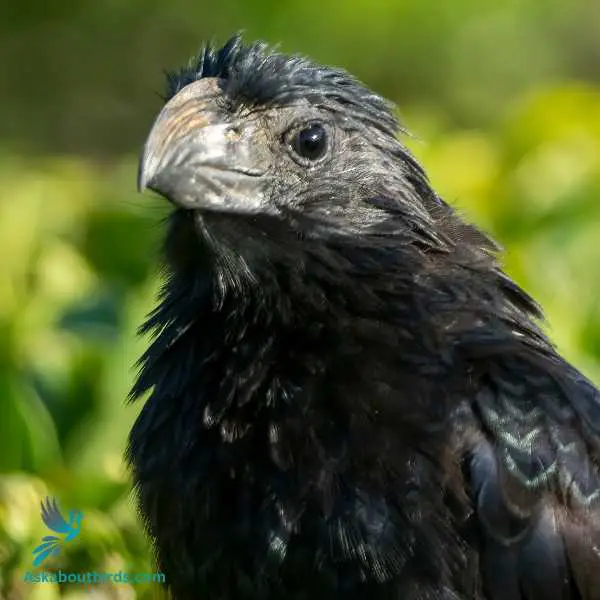
| Scientific Name | Crotophaga sulcirostris |
| Length | 13–14 inches |
| Wingspan | 18 inches |
| Weight | 2.3–5.0 oz |
The Groove-billed Ani is a tropical bird often found in open and semi-open habitats. Recognizable by its peculiar appearance, it is named for the grooved structure of its beak.
Appearance: This bird has a predominantly black plumage with a slightly glossy sheen. The Groove-billed Ani is characterized by its large, curved beak that, as its name suggests, exhibits grooves.
Diet: Their diet mainly consists of large insects and some small vertebrates. They can often be seen foraging on the ground in groups.
Reproduction: Groove-billed Anis are communal nesters, meaning multiple pairs might use the same nest. The nest is usually built in a thorny shrub or low in a tree. A single nest might contain up to 10 eggs, which are collectively incubated by the females. The chicks are cared for by multiple adults.
Bronzed Cowbird
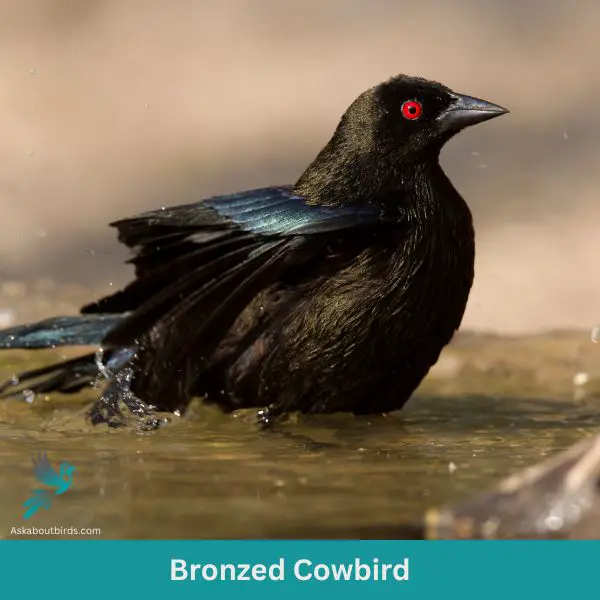

| Scientific Name | Molothrus aeneus |
| Length | 7.5–8.7 inches |
| Wingspan | 13–14 inches |
| Weight | 1.6–2.0 oz |
The Bronzed Cowbird is known for its shiny, dark plumage and brood parasitic behavior, where it lays its eggs in the nests of other bird species.
Appearance: The Bronzed Cowbird, predominantly male, has a glossy bronze-brown body. Its eyes are strikingly red, and its bill is conical and sharp.
Diet: Their diet mainly consists of seeds and insects. They often feed on the ground, scavenging for grains and catching insects mid-air.
Reproduction: Unlike many birds, the Bronzed Cowbird does not build its own nest. Instead, it practices brood parasitism by laying its eggs in the nests of other birds. The host bird often ends up raising the cowbird chick, sometimes at the expense of its own offspring.
Brewer’s Blackbird


| Scientific Name | Euphagus cyanocephalus |
| Length | 8.7–10.2 inches |
| Wingspan | 14–16 inches |
| Weight | 2.1–3.1 oz |
The Brewer’s Blackbird is easily recognized by its glossy black (males) or brown (females) plumage and its habitats in open fields and urban environments.
Appearance: Male Brewer’s Blackbirds have iridescent black plumage with a hint of green or purple sheen, while females are mostly dull brown. Both have a distinct pale eye, but it is particularly noticeable in males with their bright yellow eyes.
Diet: Brewer’s Blackbirds are omnivores. Their diet consists largely of seeds and grains, but they also feed on insects, especially during the breeding season. They often forage on the ground in open areas or parking lots.
Reproduction: Brewer’s Blackbirds typically build shallow cup-shaped nests using twigs, grasses, and other vegetation. These are often placed on the ground or low shrubs. The female usually lays a clutch of 3 to 6 eggs, which she incubates herself.
Bobolink
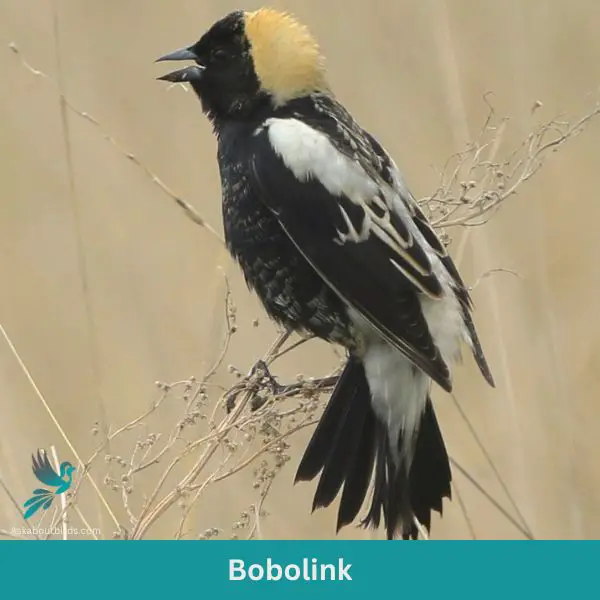

| Scientific Name | Dolichonyx oryzivorus |
| Length | 6–7 inches |
| Wingspan | 11–12.2 inches |
| Weight | 0.8–1.4 oz |
The Bobolink is a small songbird known for its striking appearance during the breeding season and its long-distance migrations.
Appearance: Male Bobolinks in their breeding plumage are unique, with a black underside, a white back, and a rich buffy nape. Outside the breeding season, males resemble the dark brown, streaked appearance of females, although the latter typically has a paler breast.
Diet: Bobolinks primarily feed on insects, especially in the breeding season, and seeds. During migration and in their wintering grounds, they frequently feed on rice, earning them the nickname “rice bird.”
Reproduction: Bobolinks typically nest in grassy fields and meadows. The nest is a well-concealed cup placed directly on the ground. The female lays a clutch of 4 to 6 eggs, which she incubates for about 10 to 12 days. The male plays a role in feeding the chicks after they hatch.
Black Swift

| Scientific Name | Cypseloides niger |
| Length | 7–7.5 inches |
| Wingspan | 15–16 inches |
| Weight | 1.2–1.4 oz |
The Black Swift is a medium-sized bird recognized for its streamlined body and long wings, adapted for fast and agile flight.
Appearance: The Black Swift is characterized by its uniformly dark plumage, which ranges from black to dark sooty gray. Its wings are long and narrow, and its tail is slightly forked, making it adept at aerial maneuvers.
Diet: Black Swifts primarily feed on flying insects. They capture their prey in mid-air, making use of their agile flying skills. Their diet includes a variety of insects, from small beetles to flying ants.
Reproduction: Black Swifts are known for nesting in unique locations, often behind waterfalls or on damp cliffs. Their nesting sites are typically inaccessible to most predators. The female typically lays a single white egg, and both parents take turns incubating it and feeding the chick once it hatches.
Rusty Blackbird

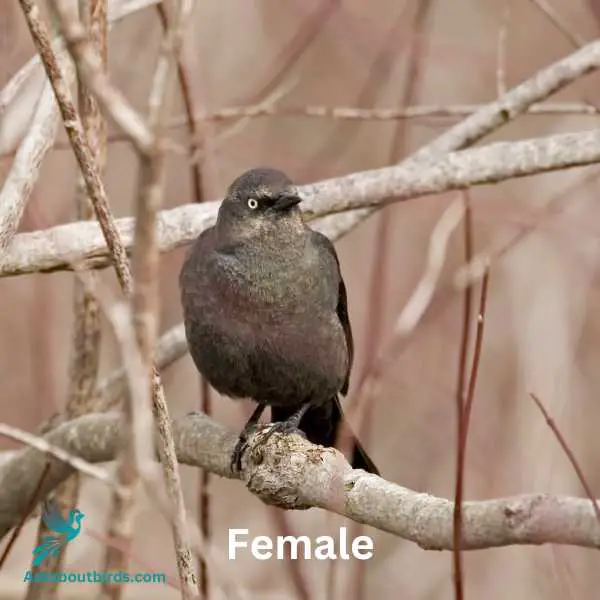
Scientific Name: Euphagus carolinus
Length: 8-9 inches
Wingspan: 13-15 inches
Weight: 1.0-2.1 oz
The Rusty Blackbird is a medium-sized blackbird that’s recognized for its distinct seasonal change in feather coloring.
Appearance: In the non-breeding season, the Rusty Blackbird earns its name, displaying a rusty-brown feathered appearance. During the breeding season, males turn glossy black while females exhibit a more muted shade with traces of rust on their feathers.
Diet: Rusty Blackbirds primarily consume insects, seeds, and occasionally aquatic creatures. They can be found foraging in wet woodlands, marshes, and near the edges of ponds and streams.
Reproduction: Rusty Blackbirds typically nest in wet woodlands or swamps. Their nests are made of grass, sedges, and moss. The female lays a clutch of about 3 to 6 eggs.
Frequently Asked Questions
What are the common black birds found in Florida?
Florida is home to several species of black birds, including the American Crow, Common Grackle, Red-winged Blackbird, and Boat-tailed Grackle.
Which black bird species are native to Texas?
Texas has a diverse range of black bird species, including the Great-tailed Grackle, Common Grackle, Red-winged Blackbird, and Brewer’s Blackbird.
What is the difference between a Brewer’s blackbird and a crow?
Brewer’s Blackbirds and Crows are different in size, with Brewer’s Blackbirds being smaller than Crows. Additionally, Brewer’s Blackbirds have shorter tails than Crows.
What are some other black birds besides crows?
There are several species of black birds besides crows, including the Common Grackle, Red-winged Blackbird, Brewer’s Blackbird, and Brown-headed Cowbird.
Which black bird species is usually all black?
The Common Raven is a black bird species that is usually all black.
How many different species of black birds are there?
There are many different species of black birds, including the American Crow, Common Raven, European Starling, Common Grackle, Brown-headed Cowbird, and Red-winged Blackbird, among others. In total, there are over 20 species of black birds found in Western north america, south america and central america.

